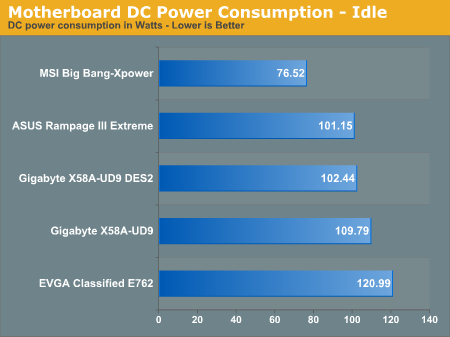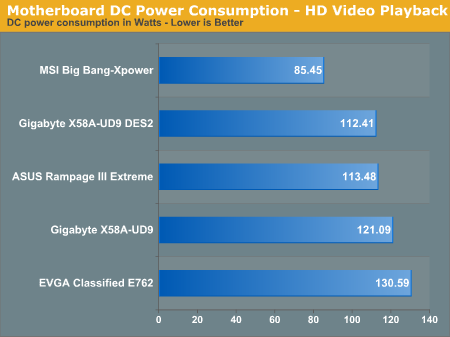ASUS, EVGA, Gigabyte & MSI: Four Flagship X58 Motherboards Reviewed
by Rajinder Gill on July 15, 2010 10:00 PM EST|
Testbed Setup Overclocking / Benchmark Testbed |
|
| Processor |
Intel i7-980X ES - 3.33GHz, 6 cores, 12 threads. 12MB L3 Cache Intel i7-980X Retail - 3.33GHz, 6 cores, 12 threads. 12MB L3 Cache |
| CPU Voltage | Various |
| Cooling | Intel air cooler, Heatkiller 3.0 waterblock, 2 x PA120.2 radiators and 2 x DDC ultra pumps (with Petra top) in series, 1/2 ID tubing for watercooling. |
| Power Supply | Corsair HX950, PCP Turbo Cool 1200W |
| Memory |
Corsair Dominator GT 8-8-8-24 2200MHz 4GB kit G.Skill Perfect Storm 8-8-8-24 2200MHz 4GB kit. |
| Memory Settings | Various |
| Video Cards | MSI N275 Lightning |
| Video Drivers | nVidia 197.45 WHQL |
| Hard Drive |
Western Digital 7200RPM 1TB SATA 3/Gbps 32MB Buffer OCZ Vertex 120GB SSD |
| Optical Drives | Plextor PX-B900A, Toshiba SD-H802A |
| Case |
Open Test Bed - Dimastech Benching Station Lian-Li V2110 |
| Operating System | Windows 7 64 bit |
| . | |
We utilized memory kits from Corsair and G.Skill to verify memory compatibility on our test boards. Our OS and primary applications are loaded on the OCZ Vertex 120GB SSD drive and our games operate off the WD Caviar Black 1TB drive. We did a clean install of the OS and applications for each motherboard. For graphics duty, MSI’s GTX N275 GPUs are used to provide performance comparisons between boards during gaming benchmarks.
For our test results we set up each board as closely as possible in regards to memory timings, Uncore, QPI frequency and also match up C-state parameters. The X58 boards utilized 6GB of memory throughout the course of benchmarking compares. Memory timings are set to 7-7-7-20 1T @ DDR3-1333 for the stock benchmarks and 8-8-8-24 1T DDR3-1600 for the 4GHz processor overclock compares.
We’ve recently updated our graphics drivers to nVidia’s WHQL 197.45 so are a little thin on platform compare results. However, there are a few reviews where gaming performance of X58, P55 and AMD platform compares have been made here and here.
Power Consumption
Our power consumption testing utilizes the same batch of components under similar circumstances in a bid to monitor variances between idle and CPU load conditions. We install the vendor supplied power saving utilities on each board and enable power saving modes that don't involve any kind of underclocking or CPU core frequency modulation in order to run an apples to apples comparison.
ATX PSU switching losses are absent from our figures because we monitor power consumption directly at the DC rails of the PSU. These figures measure only the CPU, motherboard, memory and GPU PCIe power draw via the motherboard and exclude any other peripherals, such as cooling fans and hard drives etc. Actual AC power consumption for the motherboard will be anywhere from 15~40% higher than these figures depending upon the efficiency of your power supply and choice of GPU.



Unsurprising that the MSI board comes out on top in these tests. Gigabyte’s UD9 fares well in comparison to the ASUS Rampage III Extreme with DES power saving modes engaged (considering it has two NF200 chips in tow). EVGA trails in all tests behind the UD9 for raw efficiency because the Volterra VRM used for CPU Vcore duty operates at a base switching frequency of 800KHz.










52 Comments
View All Comments
Etern205 - Friday, July 16, 2010 - link
People who get this all they cared about is the amount of nonsense that's place on these board and the size of their e-penis without any thought as to whether spending this much will bring the same in return.SniperWulf - Friday, July 16, 2010 - link
It's official, Gigabyte is officially off their rocker!Now I get that they don't expect to sell these to everyone, but still for what you get, it's totally not worth it. I bet this board still has crappy fan controls too...
MGSsancho - Friday, July 16, 2010 - link
Could you tell up what ACPI version these mobos use? I was able to find out the Gigabyte X58A-UD9 uses ACPI 1.0b but c'mon people version 4 is out. I have gone to every common mobo website and there is no board that supports anything higher than 2. Supermicro does sell version 3.0 and 4.0 on their latest offerings. ACPI is important to those of use who run other Operating systems and want to be able to use all those fancy power saving features with out drivers.Having many PCIE lanes is awesome for those of us into making file servers. But I suppose I am just better off with a server mobo, ECC ram and its better features
xetura - Friday, July 16, 2010 - link
These I7 setups are great and all, but they're still way too expensive. My q6600@3.6ghz still does just fine. I can't justify spending $650 for a mobo, cpu and ram setup that doesn't perform that much better than my setup. Sure, if I had SLI or XFIRE it will be a big jump, but I don't have either.Finally - Saturday, July 17, 2010 - link
...when was the last time, AT reviewed an AMD chipset board?4 (!) months ago. Just click on the big "motherboard" button above.
Check out the ratio Intel:AMD...
Funnily enough the last AMD board had its price right in the title: $140!
...seriously, guys. If you have to admit to yourselves, that you are running out of Intel board to review, MAYBE test something I'm actually interested in.
tercathian - Sunday, July 18, 2010 - link
Yeah, 19 of 20 reviews on Intel, some as multiple boards (just on the first/latest directory page). 1 AMD board review????Balance, AT, Balance!
What are the good, the bad, the great, and the ugly of AMD boards out there currently?
ggathagan - Sunday, July 18, 2010 - link
So...What was your translation of the first paragraph of the article?
You know, where Raja stated:
"Thus far, we’ve spent most of 2010 focusing on mainstream segments for our motherboards reviews, there’s more of that to come over the next few months starting off with a long overdue focus on AMD"
MaxMax - Saturday, July 17, 2010 - link
WTF !!$700 for a motherboard ?!
What so special about it even $200 - $250 motherboards bypass it !!
It is not even fit in my Coolermaster HAF 932 case !!
They got mad !!
MacGyverSG1 - Monday, July 19, 2010 - link
I have read a few reviews and I think the memory problem might only affect the early production boards. I noticed in your pictures, and you stated, that the SATA 6GB/s ports are facing up. Other reviews have pictures that show the SATA 6GB/s ports at a 90 degree angle like the rest. I also was able to see that that board was v1.1. Maybe you have a v1.0 board that had problems that were fixed with v1.1?Rajinder Gill - Monday, July 19, 2010 - link
Hi,The rev 1.0 change is an input inductor change (to support the OCP increase), a default OCP for VCC increase to 360 amps. plus a small change for PSU startup. These modifications were performed by MSI (by hand) to our second board before they shipped it out to us. Further, there are retail consumers with rev 1.1 boards reporting memory issues like ours.
Hope this helps.
-Raja